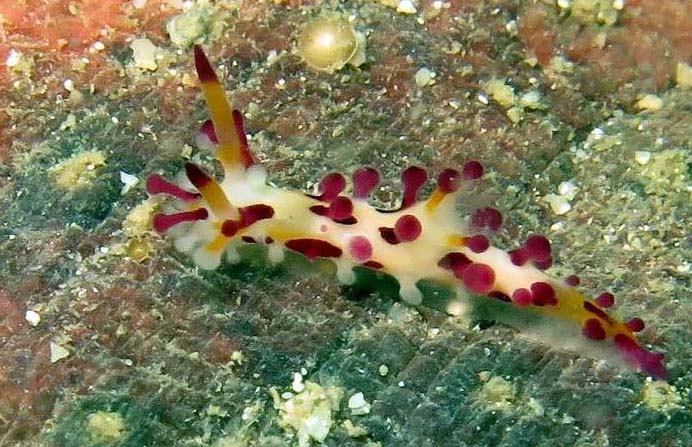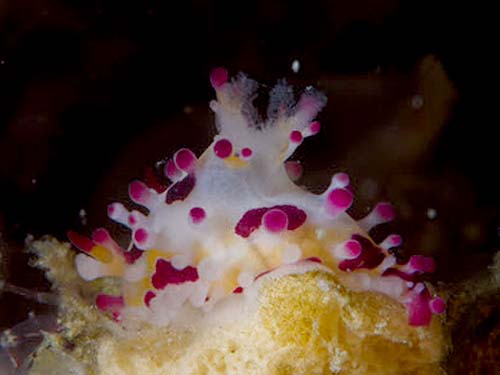This species has been observed on Mayotte, Madagascar and Seychelles Islands
Species characteristics : The mantle and the tail have spicules arranged into numerous, high papillae, each being narrow with an enlarged spherical cap. Most papillae have a magenta spot at the summit, but some papillae, especially on the sides, are white The body is generally opaque white with some yellow or apricot/orange patches dorsally.They are also usually some magenta spots and streaks on the dorsum
|

|
|
| Showing species characteristics... | Photo Emmanuelle Aigle Mayotte, Bandrele, 4 m, 25 December 2009, size : 10-20 mm |
|
Remarks :
Identification confirmed by Nathalie Yonow
Synonymous : (according Worms)
- No other name
Bibliographic data :
The body feels very firm because the skin is toughened with tiny rods (spicules)
All species in this genus have morphologically distinct papillae situated around the gill and rhinophores, presumably providing protection.
The two or three white feathery gills are protected by a row of branching papillae over-arching them. These papillae are the only ones which appear branched or confluent at their bases, all the others are solitary.
The large, simple and smooth rhinophores are protected by several papillae. They are very long, translucent at the base fading rapidly into white, orange, and deep violet for the distal third.
Note the smooth rhinophores without any elaboration, which are characteristic of the Aegiridae and unique among dorids.
This species exhibits considerable variation in color pattern :
- In some animals the apricot/orange predominates as the major color
- The papillae are multicoloured, white, orange, and lilac, mostly with deep violet tips
- The rhinophores usually have a white base, and a pinkish, creamish or orange central section, and always a magenta apex. Occasionally the rhinophores are uniformly magenta.
In juveniles the papillae are proportionally much longer than in adults
The species of the genus Aegires are all small, and feed on calcareous sponges. A. villosus feeds on a calcareous sponges belonging to the genus Leucetta
References :
Bill Rudman Seaslug site : Sea Slug Forum : Aegires villosus
Nudipixel Aegires villosus
Publications :
Fahey S.J. & T.M. Gosliner. 2004. A Phylogenetic Analysis of the Aegiridae Fischer, 1883 (Mollusca, Nudibranchia, Phanerobranchia) with Descriptions of Eight New Species and a Reassessment of Phanerobranch Relationships. Proceedings of the California Academy of Sciences 55 (34): 613-689, 82 figs., 4 tables.
Farran, G.P. (1905). Report on the opisthobranchiate Mollusca collected by Professor Herdman, at Ceylon, in 1902. In: Report to the Government of Ceylon on the Pearl Oyster fisheries of the Gulf Of Manaar. Suppl. Rep. No. 21 : 329-364, Pls. 1-6.
Other photos of Aegires villosus :
Alain-Benoît Rassat Madagascar, Nosy Bé, 15 m, size : 15 mm |
 |
|
Christophe Mason-Parker Seychelles, L'ilot, Mahé, 27 Jully 2014, size : 25 mm
|
More photos from Indian Ocean
If you have taken a photo of this species in Reunion, Mayotte or Mauritius Islands, please Contact us...
